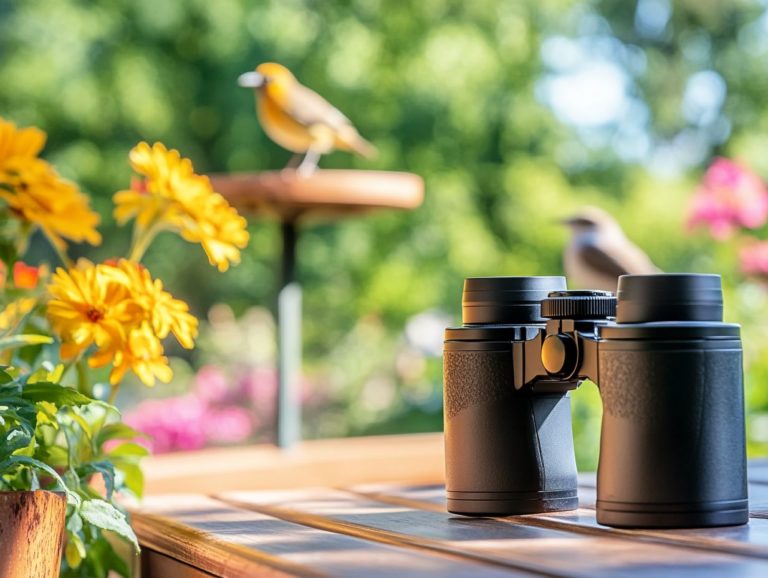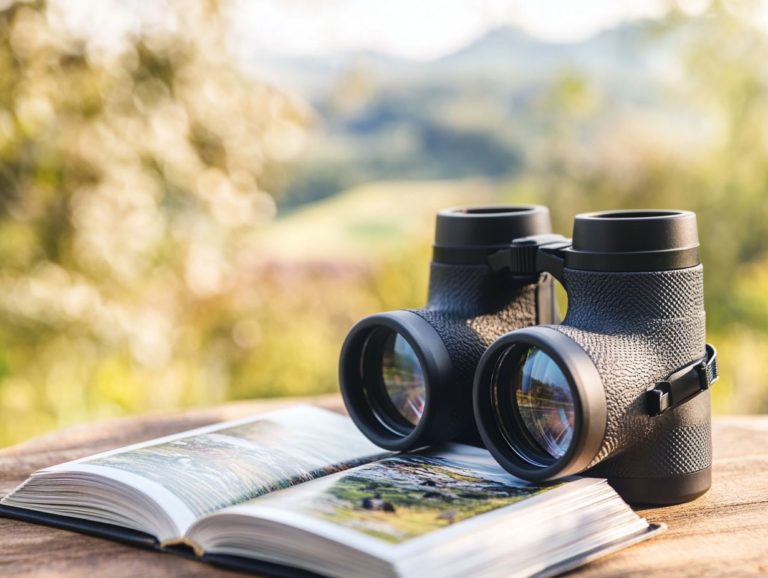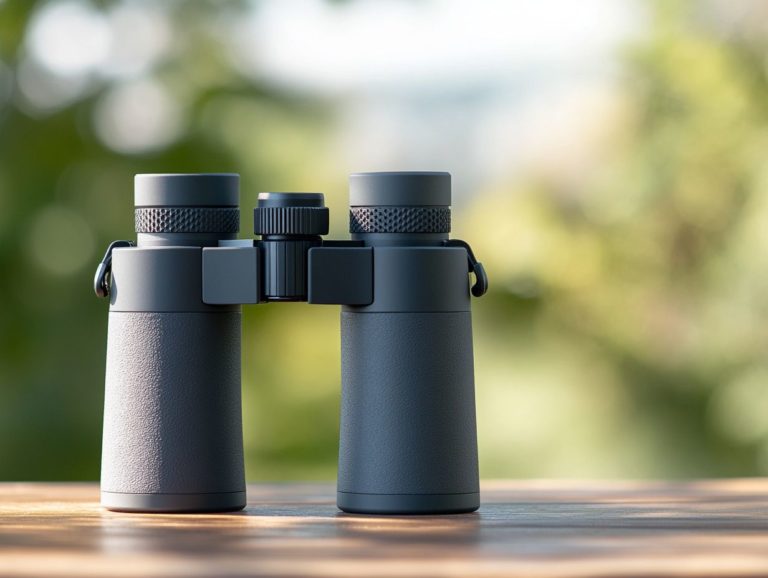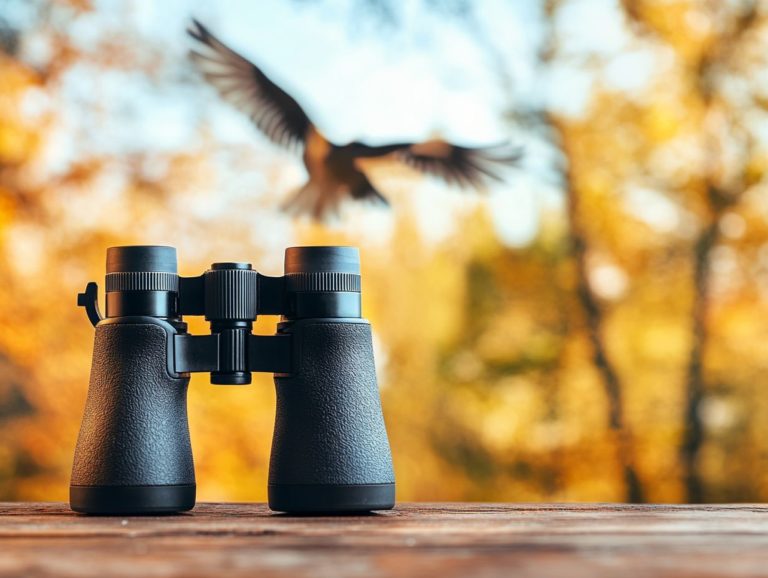What Makes a Great Pair of Bird Watching Binoculars?
Bird watching is an enthralling hobby that invites you to connect deeply with nature while appreciating the exquisite beauty of avian life. High-quality binoculars can elevate your birding experience remarkably, enhancing your observations and helping you appreciate the full range of avian qualities.
Get ready to explore key features that will make your bird watching unforgettable! This guide will walk you through essential aspects to consider, including magnification, field of view, lens types, and ergonomics for optimal performance.
Delve into the various types of binoculars available on the market, including compact and full-size options, and uncover practical tips for choosing and using them effectively. Whether you re just starting or have years of experience, the right binoculars can truly transform your bird watching adventures.
Contents
- Key Takeaways:
- What are Bird Watching Binoculars?
- Features to Consider
- Types of Birdwatching Binoculars
- Choosing the Right Binoculars for Your Needs
- Tips for Using Birdwatching Binoculars
- Frequently Asked Questions
- What Makes a Great Pair of Bird Watching Binoculars?
- What should I look for when buying bird watching binoculars?
- Do I need a specific type of binoculars for bird watching?
- What is the ideal magnification for bird watching binoculars?
- What is the field of view and why is it important for bird watching?
- Can I use binoculars with glasses for bird watching?
Key Takeaways:
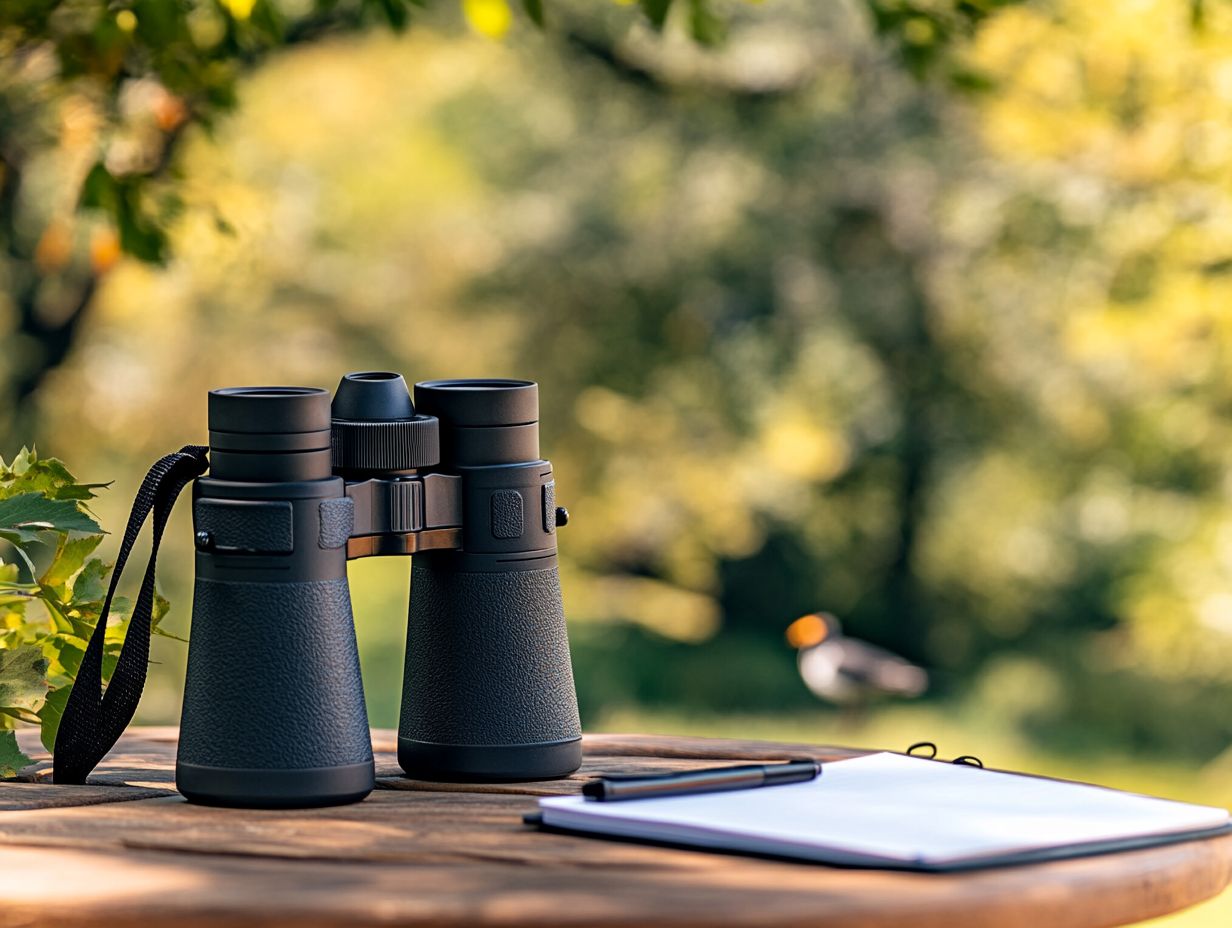
- Consider magnification and lens size for better clarity.
- Field of view helps you see more of the bird and get closer.
- Roof prism and porro prism are two common types choose the one that suits your needs best.
What are Bird Watching Binoculars?
Bird watching binoculars are specialized optical instruments crafted to enhance your birding experience. They enable you to observe and appreciate birds in their natural habitats with stunning clarity and detail.
Unlike standard binoculars, birding binoculars have special features like lightweight construction, high magnification, and a wide field of view, making them essential for avid birders eager to immerse themselves in this fulfilling pursuit.
With a plethora of brands and options available, selecting the right binoculars can significantly enhance your observations and enrich your overall bird watching adventures.
Features to Consider
When selecting binoculars for bird watching, it s essential to understand the key features that will enhance your experience. Pay attention to specifications like magnification power, often expressed as numbers such as 8×42. This indicates both how much larger an object looks compared to the naked eye and the diameter of the objective lens.
These factors significantly affect how well your binoculars can pick up light and show clearer images. Ergonomics are vital for your comfort and usability, especially during those long viewing sessions. Consider the weight of the binoculars to ensure they are easy to carry on your adventures.
Magnification and Objective Lens Size
Magnification and objective lens size are crucial in determining how effective your bird watching binoculars will be, directly impacting the quality of your viewing experience.
When you see numbers like 8x or 10x, they indicate magnification, showing how much larger an object appears compared to the naked eye. The objective lens size, measured in millimeters, plays a significant role in how much light your binoculars can gather. Generally, a larger diameter results in brighter images, making it easier for you to spot birds in various environments, especially during low-light situations.
For instance, during dawn or dusk those magical hours when birds are most active a pair of binoculars with a 42mm objective lens can capture more light, enhancing your visibility in dim conditions. Conversely, higher magnification is a game-changer in open fields, allowing you to spot distant raptors gliding gracefully in the sky.
Just remember, while high magnifications offer stunning views, they may also lead to shaky images if not stabilized properly, posing a challenge on windy days. Selecting the right combination of magnification and lens size is essential for adapting to different lighting conditions, ensuring a well-rounded birding experience no matter the time of day or environmental challenges.
Field of View and Close Focus
Field of view and close focus capabilities are crucial elements in birdwatching binoculars. They significantly shape how you interact with your surroundings while observing avian life.
A wider field of view allows you to track those fast-moving birds with greater ease. The ability to focus closely enables you to examine nearby subjects in detail without the hassle of frequent adjustments.
Together, these features elevate your overall birding experience, granting you the flexibility to adapt to various environments and situations.
As you choose your binoculars, it s important to think about the specific locales you frequent. Different settings may demand different levels of focus and field.
For instance, if you often find yourself by the coast, a wider field might help you spot migrating flocks. Conversely, if you re a forest aficionado, you might lean toward binoculars with superior close focus to catch glimpses of those elusive species nestled among the dense foliage.
Many experienced birders suggest testing out several models in the field to discover your perfect fit. Personal anecdotes reveal that the right pair can dramatically enhance your experience whether it s capturing the fleeting moment of a warbler darting by or noticing the subtle hues of a perched hawk.
Such details can elevate an ordinary outing into an unforgettable adventure.
Prism Type and Coatings
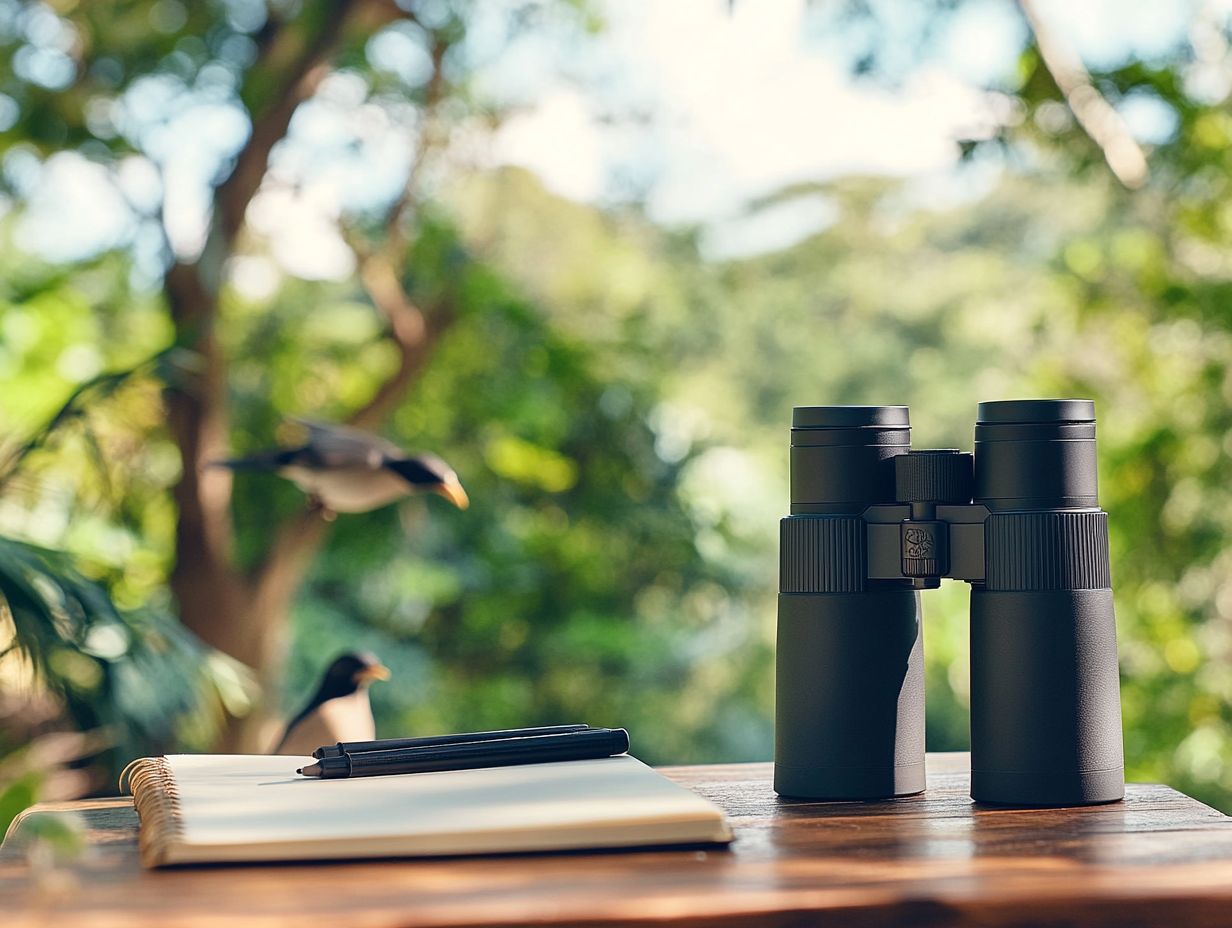
The type of prism system and lens coatings you choose for birdwatching binoculars can significantly impact how clear the images are and overall performance. This shapes how you perceive images while out in the field.
For dedicated birdwatchers, grasping the differences between these prism types is essential for enhancing your viewing experience. Roof prisms are often more compact and user-friendly, making them a favored option for those who value portability.
On the other hand, Porro prisms typically offer a wider field of view, which can be invaluable for tracking those elusive, fast-moving birds.
The coatings on the lenses also play a crucial role, providing notable enhancements in brightness and color accuracy. This can make all the difference when it comes to identifying species or noticing subtle variations in plumage.
Ultimately, the right combination of prism type and lens coatings can truly elevate your enjoyment of spotting birds in their natural habitats.
Types of Birdwatching Binoculars
Grasping the different types of birdwatching binoculars available on the market is crucial for making informed purchasing decisions that align with your specific needs and preferences.
Broadly categorized into compact and full-size options, these binoculars vary in size, weight, and optical performance. Each caters to distinct birding styles and environments.
You can also choose between roof prism and Porro prism designs, each presenting unique advantages in ergonomics, portability, and viewing comfort.
It s essential to consider how these factors resonate with your individual birding experiences.
Compact vs Full-size
When you’re comparing compact and full-size birdwatching binoculars, weight and size become crucial elements to consider for your birding adventures. Compact binoculars are crafted for lightweight travel, making them the perfect companions if you prioritize mobility and convenience.
On the other hand, full-size models typically deliver superior optical performance and stability, ideal for those longer viewing sessions. Each type offers a unique experience.
By understanding their distinct characteristics, you can make more informed choices tailored to your specific birding activities.
For instance, if you’re venturing into remote hiking trails, you might find yourself leaning towards compact options. These models slip effortlessly into your backpack without weighing you down.
Conversely, if you re a seasoned birdwatcher planning to observe for extended periods, full-size binoculars may be your best bet. They generally offer clearer images and greater depth of field.
User experiences reveal that while compact binoculars excel during casual outings, full-size alternatives truly shine in dedicated birding settings where clarity and precision are paramount.
By weighing these factors carefully, you can select equipment that enhances both your enjoyment and effectiveness when observing wildlife!
Explore your options today to find the perfect binoculars for your adventures!
Roof Prism vs Porro Prism
Choosing between roof prism and Porro prism binoculars can greatly affect your birdwatching experience. Each type has its own unique advantages and disadvantages.
Roof prism binoculars are popular for their sleek, lightweight design, making them ideal for long outings. Porro prism binoculars, however, often provide a broader view, allowing you to see more detail and vibrant colors.
Think about where you plan to birdwatch. If weight is crucial on hikes, a roof prism model is a smart choice. But if you re enjoying a relaxed day in a stable setting, the enhanced experience of Porro prisms can be more rewarding.
Finding the right balance between portability and great image quality is key to choosing the best binoculars for bird watching trips during your birdwatching adventures.
Choosing the Right Binoculars for Your Needs
Choosing the right binoculars requires a thoughtful assessment of several key factors that can significantly impact performance and your enjoyment during birding excursions.
Consider specific criteria like magnification (how much closer things appear), field of view, weight, and ergonomics to find the binoculars that best suit your birding adventures and environments.
By making informed decisions about these investments, you can greatly elevate your observations and enhance your enjoyment of birdwatching as a cherished hobby.
Factors to Consider
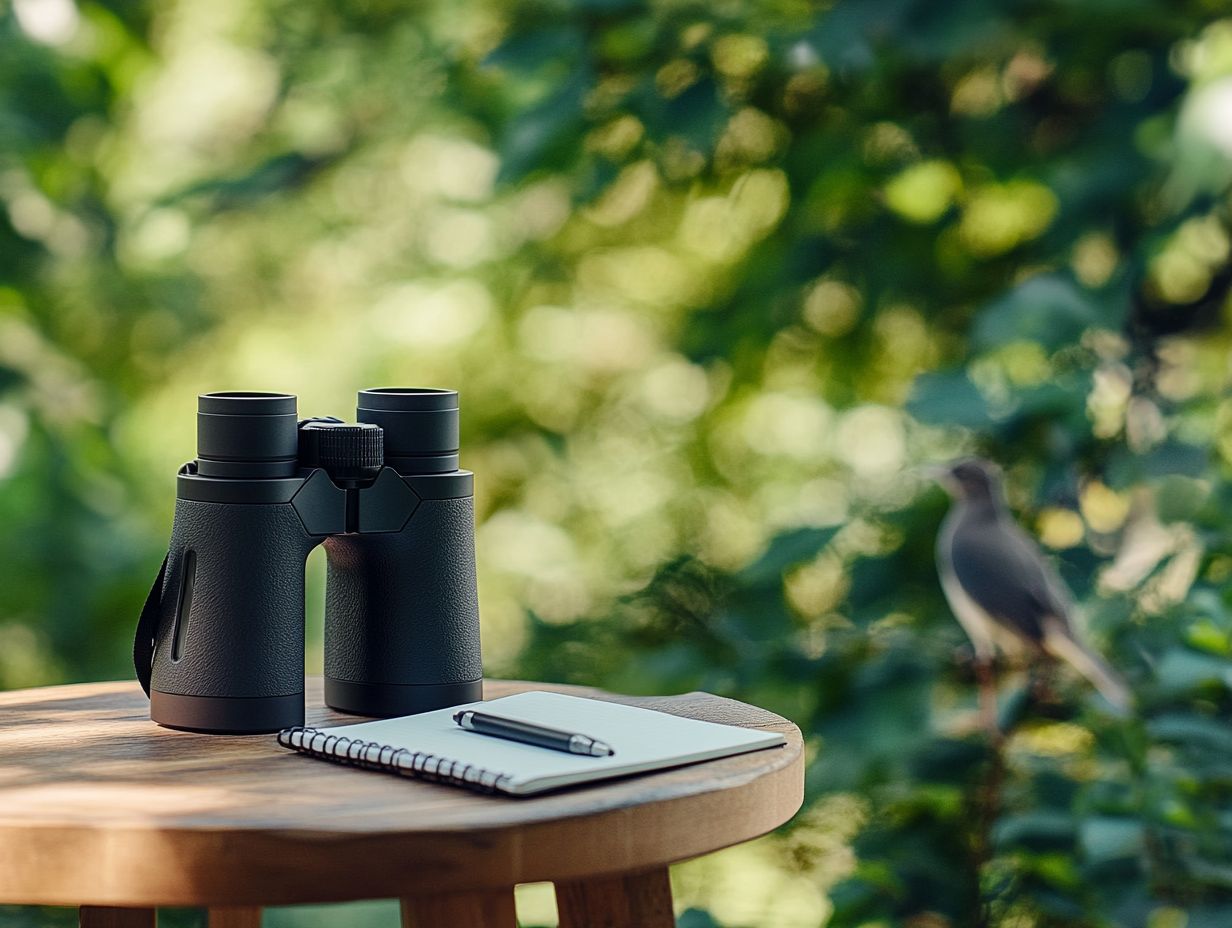
When evaluating birdwatching binoculars, several factors are crucial for optimal performance and satisfaction during your birding adventures. Key specifications like magnification, objective lens size, weight, and ergonomics directly influence your experience.
If you’re venturing into a dense forest, lightweight binoculars with superior ergonomics are essential for comfortable extended use. This lets you effortlessly track fast-moving birds without getting tired.
On the other hand, when soaking in distant vistas from a mountain summit, high magnification combined with an optimal objective lens size can be a game-changer for spotting elusive species.
This interplay between specifications is evident in real-life scenarios; imagine choosing a compact, waterproof model for coastal excursions, where unpredictable weather adds challenges, ensuring your equipment remains reliable in various environments.
Tips for Using Birdwatching Binoculars
Maximizing the effectiveness of your birdwatching binoculars requires a keen understanding of techniques that enhance your experience during excursions. Familiarizing yourself with the proper way to hold and adjust your binoculars, along with mastering techniques for focusing and tracking birds in motion, can lead to significant improvements in observation quality.
Regular maintenance and care of your binoculars will ensure their longevity and consistent performance, allowing you to fully immerse yourself in and enjoy every moment of your birding adventures.
Proper Techniques and Maintenance
Proper techniques and regular maintenance keep your birdwatching binoculars in great condition. This ensures high-quality viewing experiences over time.
Hold the binoculars with both hands at eye level. This minimizes shake and enhances clarity.
Adjust the diopter periodically to match your vision. This helps bring every detail into focus.
Check for dust or moisture on the lenses regularly. Use a soft, lint-free cloth to clean them and prevent scratches.
Store your binoculars in a dry, cool place. Use silica gel packs to prevent moisture buildup.
Frequently Asked Questions
What Makes a Great Pair of Bird Watching Binoculars?
Look for binoculars that offer great magnification and a wide field of view. These features enhance your birdwatching experience, and knowing what to look for in bird watching gear can make all the difference!
What should I look for when buying bird watching binoculars?
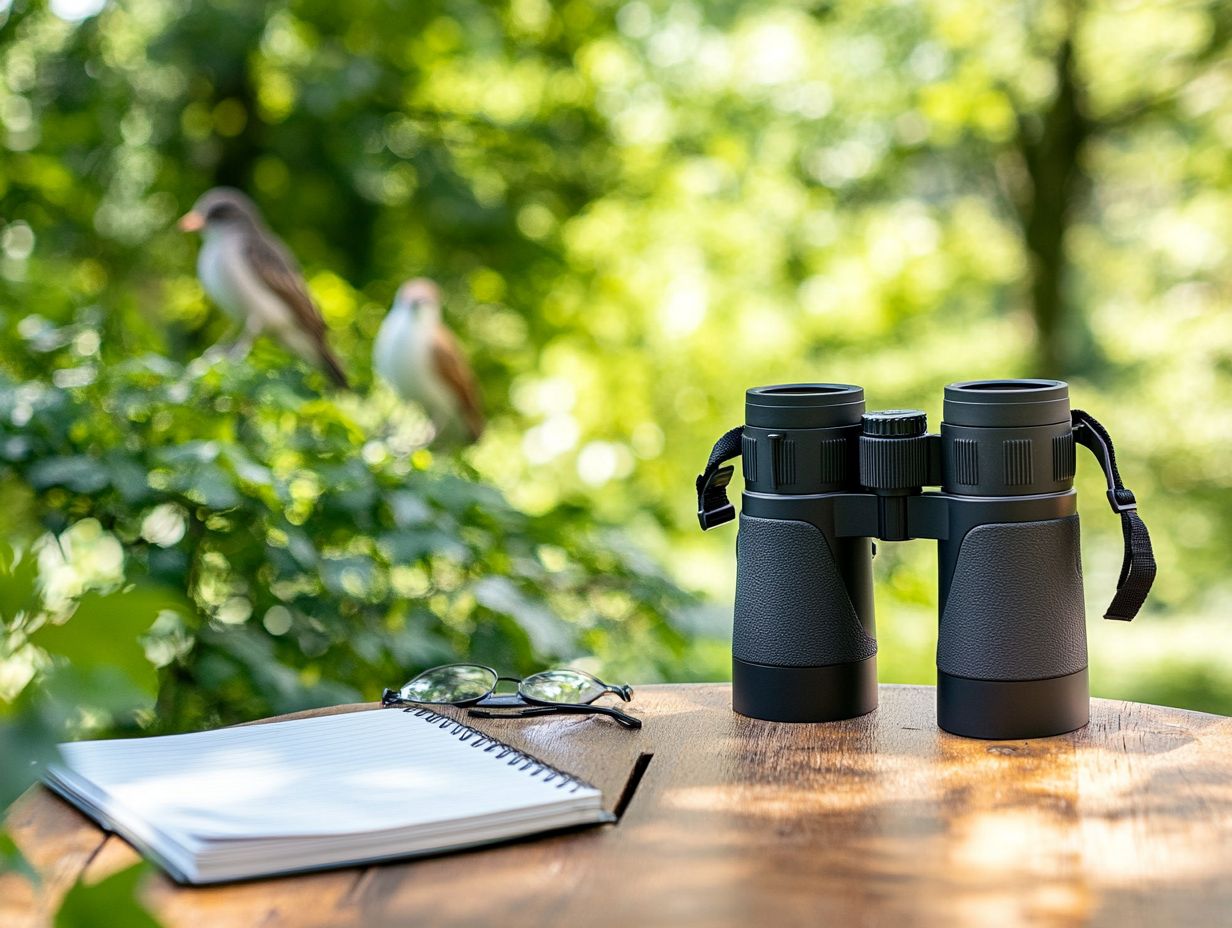
When buying bird watching binoculars, look for a compact and lightweight design, a comfortable grip, and features such as waterproofing and anti-fogging. For more detailed advice, check out what to look for when buying birding binoculars.
Do I need a specific type of binoculars for bird watching?
While any binoculars can be used for bird watching, those specifically designed for this hobby will have features that make it easier, such as close focus and image stabilization.
What is the ideal magnification for bird watching binoculars?
The ideal magnification for bird watching binoculars is between 8x and 10x. This allows for a good balance between magnification and stability.
What is the field of view and why is it important for bird watching?
The field of view is the width of the area you can see through the binoculars at a specific distance. A wide field of view is important for bird watching as it allows you to spot birds quickly and easily.
Can I use binoculars with glasses for bird watching?
Yes, there are binoculars specifically designed for people wearing glasses. Look for features such as long eye relief and adjustable eyecups for a comfortable viewing experience.


